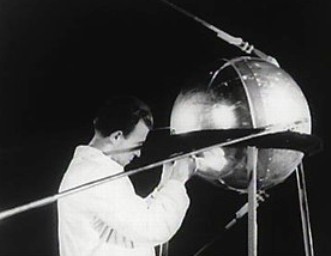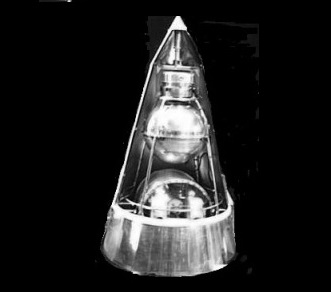|

Sputnik 1

Sputnik
2
|
Sputnik Facts: Fast Fact Sheet
Fast, fun facts and Frequently Asked Questions (FAQ's)
about the Sputnik.
What was Sputnik? The name Sputnik was
given to three artificial satellites that
were launched by the Russians into outer
space to orbit around the Earth.
What does Sputnik mean? The meaning of
the Russian word 'Sputnik' means "fellow
traveller".
When was Sputnik launched?
Sputnik-1 was launched on October 4, 1957.
What was Sputnik 1? Sputnik-1 was the
first artificial satellite that was launched
on October 4, 1957. It consisted of a small,
glistening aluminum ball with four long
antennas. The diameter of the sphere was
22.8 inches (58 cm) and it weighed about
about 184 pounds (83 kg). It traveled at
about 18,000 mph. Sputnik 1 is the most
famous of all the Sputniks because it marked
the entry of mankind into space.
What was Sputnik 2? Sputnik-2 carried a
"part-Samoyed terrier" female dog named Laika in a small separate sealed cabin.
Sputnik 2 was the second spacecraft launched
into Earth orbit, on 3 November 1957. It was
a 13 foot (4-metre) high cone-shaped
capsule with a base diameter of 6.6 feet
(2 meters) that weighed 1120 pounds (508.3
kg).
What was Sputnik 3? Sputnik-3 was
launched on May 15, 1958 and was designed to
conduct scientific experiments in space. It
was cone shaped and was 11.7 ft (3.57 m)
long and 5.68 ft (1.73 m) wide at its base.
It was the heaviest satellite weighing 2925
pounds (1,327 kg).
What happened to
Sputnik 1?
Sputnik-1 revolved around Earth for three
months before being consumed in the
atmosphere on January 4, 1958.
What is a Satellite?
Definition: A satellite is a celestial object in outer space that
orbits around a planet or a star. The word 'satellite' derives from
the French word meaning 'follower' or 'hanger-on'. The Earth is a
satellite of the Sun. An artificial satellite, such as Sputnik, is a
man-made device that is designed to be launched around the earth or
another planet. Artificial satellites are now used for
research, communications, navigation and weather information.
Sputnik Facts
for kids
The following fact
sheet contains interesting information, history and
facts on Sputnik for kids.
Sputnik
Facts for kids
Sputnik
Facts - 1: Sergei Pavlovich
Korolev (1907 - 1966) was the Soviet Union’s premier
rocket engineer and the Chief Designer of the Sputniks.
Sergei Korolev is credited as the founder of the Soviet
space program and after the success of the Sputniks he
went on to build the Vostok space capsule used for the
first human spaceflight by cosmonaut Yuri Gagarin in
1961.
Sputnik
Facts - 2: The development of the
satellite dated back to the beginning of the 1900's. The idea that a
satellite could be put into orbit around the Earth was introduced in
1903 when Konstantin Tsiolkovsky developed a mathematical theory
showing that this could be done.
Sputnik
Facts - 3: In 1948, Mikhail
Tikhonravov, an expert in spacecraft design and rocketry, spoke to
scientist Sergei Korolev about putting this theory into an actual
working device. Experts dismissed the idea but Korolev did not.
Sputnik
Facts - 4: Russian rocket
development programs had focused on missiles, not
satellite launch devices. The R-7 rocket was a Russian
missile developed during the Cold War, and the world's
first intercontinental ballistic missile (ICBM). A
nuclear-armed intercontinental ballistic missile was
guided in the first part of its flight but fell freely
as it approached its target.
Sputnik
Facts - 5: It was Sergei
Korolev who suggested the idea of using the R-7 rocket
to put a satellite in orbit in 1954. Using the R-7 to
launch an orbital satellite was an inevitable stage in
the development of rocket technology.
Sputnik
Facts - 6: Sergei Korolev transferred
Mikhail Tikhonravov to the space project to explore Tsiolkovsky's
theory and to solve the problems of rocket design for space
exploration. Mikhail Tikhonravov is therefore also closely
associated with the Russian Space program
Sputnik
Facts - 7: The ambitious
Russian space team at first attempted to design an
artificial satellite weighing nearly 3000 pounds, nearly
1.5 tons, (which later became Sputnik-3). They quickly
abandoned this satellite for a much simpler and lighter
design to prove that they could get something into space
- it became known as Sputnik-1.
Sputnik
Facts - 8: Sputnik-1 ended up
being only a small, glistening aluminum sphere with four
long antennas containing two radio transmitters,
batteries, very simple optical instruments and a
thermometer. The diameter of the small ball was 22.8
inches (58 cm) and it weighed about about 184 pounds (83
kg).
Sputnik
Facts -
9: The data
transmitted by the first satellite were the internal and
external temperatures of the sphere that were used to
analyze the spread of radio signals in the ionosphere.
Sputnik
Facts - 10: The ionosphere is
the layer of the earth's atmosphere, between the
stratosphere and the exosphere, which contains a high
concentration of ions and free electrons and is able to
reflect radio waves.
Sputnik
Facts - 11: A modified version
of the R-7 rocket missile was therefore used to place
Sputnik 1 in orbit from a launch pad at Baikonur
Cosmodrome. The Baikonur Cosmodrome was the world's
first operational space launch facility, located in the
desert steppe of Kazakhstan. Sputnik 1 was launched into
orbit from Baikonur Cosmodrome on October 4, 1957.
Sputnik
Facts for kids
Facts
about the Sputnik for kids
The following fact
sheet continues with facts about Sputnik.
Sputnik
Facts for kids
Sputnik
Facts -
12: The Russian
satellite orbited Earth at about 250 km (150 miles)
above Earth's surface. It traveled at about 18,000 mph
and took just over 96 minutes to complete each orbit of
the earth.
Sputnik
Facts - 13: The shiny aluminum ball was
invisible from Earth but Sputnik-1 made itself heard. Its
simple series of beeps were capable of being heard by anyone with a
ham radio set. The ‘bip-bip’ signals were beamed out by the
two radio transmitters at 20 and 40 MHz (15 and 7.5 long wave) which
could be captured by radio enthusiasts over the entire world.
Sputnik
Facts - 14: The launch of the world's
first artificial satellite was surprisingly treated as a very
low-key affair - everyone was focused on the rockets that carried
nuclear missiles (ICBM's). The Soviet president Nikita Kruschev said
that he considered it "just another Korolev rocket launch" and the
major Soviet newspaper Pravda only published one short paragraph
with the news.
Sputnik
Facts - 15: At the time of the
launch Sergei Korolev seemed to be one of the only
people who was really excited and realized the
importance of the event. Korolev was quoted as
saying "I've been waiting all my life for this day!"
Sputnik
Facts - 16: Soviet and American delegates
from the international scientific project (IGY) committees were at a
reception at the Russian embassy in Washington D.C. when news of
Sputnik's launch came through. The chairman of the American IGY
committee, Dr Joseph Kaplan, congratulated the Russians on a
"remarkable achievement" but most generally downplayed the
importance of the accomplishment.
Sputnik
Facts - 17: President
Eisenhower outwardly responded to the news by saying he
was not worried just because the Soviets had "put one
small ball into the air". But there were obvious
concerns from Congress when they learned that a Russian
satellite was regularly passing over America.
Sputnik
Facts - 18: When the news of
the launch of the Russian satellite the American public
were shocked and stunned and reacted with both fear and
alarm. There were many Americans who were into
amateur radio who could hear the satellite's ‘bip-bip’
signals that were a constant reminder of the Soviet's
presence above the United States.
Sputnik
Facts - 19: A lot of people,
caught up in the anti-communist hysteria and paranoia,
thought that the satellite was some kind of a weapon, or
a secret device that the Soviets could use to target
American towns and cities with atomic bombs.
Sputnik Facts - 20:
The technological
triumph by the Soviets increased the anxiety of
Americans and brought into focus the reality of the
Cold War. The American
public took it as a sign that the United States was
falling behind the Soviet Union in missile technology
bringing the risk of nuclear attack even closer. The
Soviet Union had staged a tremendous propaganda coup for
the communist system.
Sputnik
Facts -
21: Before America
could draw breath about the first satellite launched on
October 4, 1957, just a month later the Soviets
proceeded with the launch of Sputnik-2 on November 3
1957.
Sputnik
Facts -
22: Sputnik-2 carried the dog Laika. Whilst the
first Soviet satellite had weighed less than 200 pounds,
the second spacecraft weighed 1,120 pounds and would
remain in orbit for almost 200 days.
Sputnik
Facts -
23:
Sputnik 1 revolved around Earth for three
months before being consumed in the atmosphere on
January 4, 1958.
Sputnik
Facts -
24: On February 1,
1958, the United States successfully launched its own
first artificial satellite called the 'Explorer'
satellite under the
US Army's Jupiter project. The Explorer satellite was the first
spacecraft to detect the Van Allen radiation belt.
Sputnik
Facts -
25: The president and
Congress reacted to the new space technology by
replacing the National Advisory Committee for
Aeronautics (NACA) with the National Aeronautics and
Space Administration (NASA) on July 29, 1958 in order to
coordinate research in rocket science and space
exploration.
Sputnik
Facts -
26: The
Cold War Arms
Race was joined by the
Cold War Space
Race and Cold War tensions between the Soviets and the Americans
increased dramatically.
Sputnik
Facts -
27: The Sputnik launch
was dramatized in several movies including The Right
Stuff (1983), October Sky (1999) and The Iron Giant
(1999).
Sputnik
Facts -
28: A model of Sputnik
is displayed in the lobby at the United Nations
headquarters in New York. Other replicas are on display
at the Smithsonian Museum and at the Science Museum in
London.
Sputnik
Facts for kids
Sputnik Facts - President Dwight Eisenhower Video
The article on the Sputnik provides detailed facts and a summary of one of the important events during his presidential term in office. The following
Dwight Eisenhower video will
give you additional important facts and dates about the political events experienced by the 34th American President whose presidency spanned from January 20, 1953 to January 20, 1961.
Sputnik Facts
●
Facts about the Sputniks for kids and schools
●
Summary of the Sputniks in US history
●
The Sputniks, a major
event in US history
●
Dwight Eisenhower from January 20, 1953 to January 20, 1961
●
Fast, fun facts about the Sputniks
●
Foreign & Domestic
policies of President Dwight Eisenhower
● Dwight Eisenhower Presidency and
facts about Sputnik for schools,
homework, kids and children |